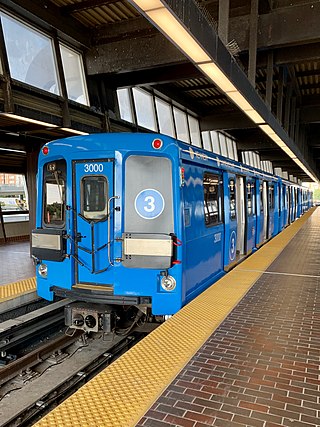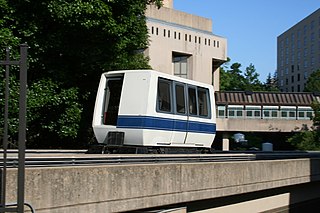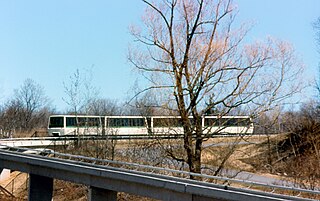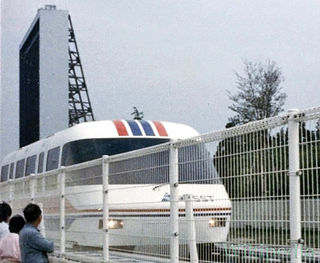Related Research Articles

A linear motor is an electric motor that has had its stator and rotor "unrolled", thus, instead of producing a torque (rotation), it produces a linear force along its length. However, linear motors are not necessarily straight. Characteristically, a linear motor's active section has ends, whereas more conventional motors are arranged as a continuous loop.

Line 3 Scarborough is a light rapid transit line that is part of the Toronto subway system in Toronto, Ontario, Canada. The line runs entirely within the suburban district of Scarborough, encompassing six stations and 6.4 kilometres (4.0 mi) of mostly elevated track. It connects with Line 2 Bloor–Danforth at its southwestern terminus, Kennedy, and terminates in the northeast at McCowan. In 2021, the system had a ridership of 2,822,300, or about 15,700 per weekday as of the third quarter of 2022.

An automated guideway transit (AGT) or automated fixed-guideway transit or automatic guideway transit system is a type of fixed guideway transit infrastructure with a riding or suspension track that supports and physically guides one or more driverless vehicles along its length. The vehicles are often rubber tired or steel wheeled, but other traction systems including air cushion, suspended monorail and maglev have been implemented. The guideway provides both physical support, like a road, as well as the guidance.

Innovia Metro is an automated rapid transit system manufactured by Alstom. Innovia Metro systems run on conventional metal rails and pull power from a third rail but are powered by a linear induction motor that provides traction by using magnetic force to pull on a "fourth rail" placed between the running rails. However, newer versions of the technology are available with standard electric rotary propulsion.

Maglev, is a system of train transportation that uses two sets of electromagnets: one set to repel and push the train up off the track, and another set to move the elevated train ahead, taking advantage of the lack of friction. Such trains rise approximately 10 centimetres (3.9 in) off the track. There are both high speed, intercity maglev systems, and low speed, urban maglev systems being built and under construction and development.

The Urban Transportation Development Corporation Ltd. (UTDC) was a Crown corporation owned by the Government of Ontario, Canada. It was established in the 1970s as a way to enter what was then expected to be a burgeoning market in advanced light rail mass transit systems. UTDC built a respected team of engineers and project managers. It developed significant expertise in linear propulsion, steerable trucks and driverless system controls which were integrated into a transit system known as the Intermediate Capacity Transit System (ICTS). It was designed to provide service at rider levels between a traditional subway on the upper end and buses and streetcars on the lower, filling a niche aimed at suburbs that were otherwise expensive to service.

Electromagnetic suspension (EMS) is the magnetic levitation of an object achieved by constantly altering the strength of a magnetic field produced by electromagnets using a feedback loop. In most cases the levitation effect is mostly due to permanent magnets as they don't have any power dissipation, with electromagnets only used to stabilize the effect.

The SCMaglev is a magnetic levitation (maglev) railway system developed by Central Japan Railway Company and the Railway Technical Research Institute.
SelTrac is a digital railway signalling technology used to automatically control the movements of rail vehicles. It was the first fully automatic moving-block signalling system to be commercially implemented.
The ACT, acronym for Automatically Controlled Transportation or Activity Center Transit, was a people mover system developed during the 1970s. One feature of the ACT is that it allowed bi-directional travel on a single rail—cars passed each other by switching onto short bypass lanes on the track, distributed where space allowed. ACT was a contender in the Urban Mass Transportation Administration's plan to deploy three or four systems in cities in the United States, as well as the GO-Urban project in Toronto, Canada. One ACT system was installed as a part of a Ford-funded real estate development near their headquarters in Dearborn, MI, and although they proposed to install ACT in several other locations, no additional systems were ever installed and the project was put on indefinite hold.
ROMAG was a personal rapid transit (PRT) system produced by the American company Rohr, Inc. It featured a linear induction motor that was arranged to provide both traction and suspension in a magnetic levitation system.
The Computer-controlled Vehicle System, almost universally referred to as CVS, was a personal rapid transit (PRT) system developed by a Japanese industrial consortium during the 1970s. Like most PRT systems under design at the same time, CVS was based around a small four-person electric vehicle similar to a small minivan that could be requested on demand and drive directly to the user's destination. Unlike other PRT systems, however, CVS also offered cargo vehicles, included "dual-use" designs that could be manually driven off the PRT network, and included the ability to stop at intersections in a conventional road-like network.

Tracked Hovercraft was an experimental high speed train developed in the United Kingdom during the 1960s. It combined two British inventions, the hovercraft and linear induction motor, in an effort to produce a train system that would provide 250 mph (400 km/h) inter-city service with lowered capital costs compared to other high-speed solutions. Substantially similar to the French Aérotrain and other hovertrain systems of the 1960s, Tracked Hovercraft suffered a similar fate to these projects when it was cancelled as a part of wide budget cuts in 1973.

A hovertrain is a type of high-speed train that replaces conventional steel wheels with hovercraft lift pads, and the conventional railway bed with a paved road-like surface, known as the track or guideway. The concept aims to eliminate rolling resistance and allow very high performance, while also simplifying the infrastructure needed to lay new lines. Hovertrain is a generic term, and the vehicles are more commonly referred to by their project names where they were developed. In the UK they are known as tracked hovercraft, in the US they are tracked air-cushion vehicles. The first hovertrain was developed by Jean Bertin (1917-1975) in France, where they were marketed as the Aérotrain before being abandoned by the French government.
GO-Urban was a planned mass transit project for Greater Toronto to be operated by GO Transit. The system envisioned the use of automated guideway transit vehicles set up in hydro corridors and other unused parcels of land to provide rapid transit services without the expense of constructing tunnels. GO-Urban would serve high-density areas in the downtown core, but also be able to accelerate to high speed between distant stations in the outskirts of the city. Similar deployments were planned for Hamilton and Ottawa.

The Dashaveyor was an automated guideway transit (AGT) system developed during the 1960s and '70s.

High Speed Surface Transport (HSST) is a Japanese maglev train system which uses electromagnetic levitation technology. The Linimo line in Aichi Prefecture, Japan, uses a descendant of HSST technology.

The University of the Philippines Diliman AGT was an automated guideway transit (AGT) system constructed for technology demonstration within the campus of the University of the Philippines (UP) in Diliman, Quezon City in the Philippines. It served as a test track for the first mass transit system to be built and developed in the country by local engineers.
Minitram was an automated guideway transit system studied by the Transport and Road Research Laboratory (TRRL), part of the UK Department of the Environment's Ministry of Transport. The system was based on small, completely automated tram-like vehicles of about 25 passengers that could be connected together into three-car trains to increase capacity. Proposed designs were submitted by Hawker Siddeley Dynamics (HSD) and EASAMS. HSD's system used rubber wheels and EASAMS' steerable steel ones, but the projects were otherwise similar and notably shared a linear motor for propulsion and most braking. A series of failed sales efforts in the UK and to the GO-Urban system in Toronto, combined with decreased government spending in the 1970s, led to the concept being abandoned.
References
Notes
- ↑ Downtown 2009
- 1 2 3 4 5 AGT 1975, p. 246.
- ↑ "Maglev: How they're Getting Trains off the Ground", Popular Science, December 1973 p. 135.
- 1 2 3 4 5 6 7 AGT 1975, p. 247.
- 1 2 AGT 1975, pg. 230
- ↑ Litvak & Maule 1982, p. 72.
- 1 2 3 4 Filey 1997, p. 39.
- ↑ Edward Levy, "The Maglev Technology", Rapid Transit in Toronto, Section 8.3
- 1 2 3 AGT 1975, p. 248.
- ↑ Litvak & Maule 1982, p. 93.
Bibliography
- Ernst Rieser, "The Transurban System", SAE International Paper 740144, February 1974
- (AGT 1975), "Automated Guideway Transit", US Government Printing office, June 1975
- Mike Filey, "Toronto Sketches 5: The Way We Were", Dundurn Press, 1997, ISBN 1-55002-292-X
- Isaiah Litvak and Christopher Maule, "The Light-Rapid Comfortable (LRC) Train and the Intermediate Capacity Transit System (ICTS): Two Case Studies of Innovation in the Urban Transportation Equipment Manufacturing Industry", University of Toronto/York University Joint Program in Transportation, 1982
Further reading
- David Francis, "Supertrains", Anchorage Daily News, 23 April 1973, pg. 11